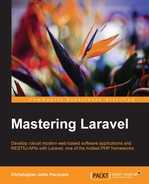Now, we can use a technique called model binding to clean up the code even more:
public function boot(Router $router)
{
parent::boot($router);
$router->model('accommodations', 'MyCompanyAccommodation'),
}In app/Providers/RouteServiceProvider.php, add the $router->model() method that accepts the route as the first argument and the model that will be bound as the second argument.
Now, our
show controller method looks like this:
public function show(Accommodation $accommodation)
{
return $accommodation;
}When /accommodations/1 is called, for example, the model that corresponds to that ID will be injected into the method, allowing us to substitute the find method.
Similarly, for the list method, we inject the type-hinted model as follows:
public function index(Accommodation $accommodation)
{
return $accommodation;
}Likewise, the
update method now looks like this:
public function update(Accommodation $accommodation)
{
$input = Input::json();
$accommodation->name = $input->get('name'),
$accommodation->description = $input->get('description'),
$accommodation->location_id = $input->get('location_id'),
$accommodation->save();
return response($accommodation, 200)
->header('Content-Type', 'application/json'),
}..................Content has been hidden....................
You can't read the all page of ebook, please click here login for view all page.
